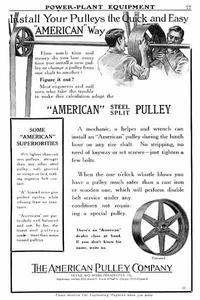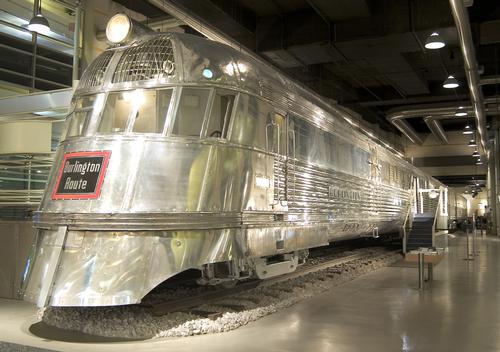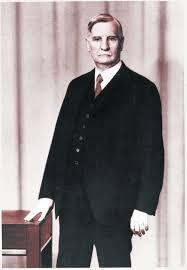A History Minute | Fortunes of Philadelphia: Planes, Trains, and Automobiles – The Story of Budd Manufacturing
By Sally F."Stronger, lighter, safer" was the goal Edward Budd pursued his entire life. Along the way he built the largest manufacturing company in Philadelphia and forever changed the way the world travels.
Edward G. Budd 
Budd saw a future for pressed steel far greater than pulleys. In 1902, he moved to Hale & Killburn, a major producer of railroad and trolley furniture. Railroad cars and trolleys were built of wood and cast iron and still resembled the trains of the Victorian Age. Budd designed railroad car seats made of pressed steel that were cheaper to produce, lighter in weight, and stronger than the old seats. Introduced in 1904, these seats became the industry standard for over 30 years. Budd went on to engineer all-steel passenger cars for the Pullman Company.
 Budd left to start the Edward Budd Manufacturing Co. in 1911. He took Joseph V. Ledwinka with him, an Austrian immigrant who was a wizard with sheet metal. They set up shop in Kensington in a small rented building with a circus tent outside to cover the large stamping machine. Budd and Ledwinka set their sights on replacing wood auto bodies with welded all-metal bodies. But first they had to design and build equipment to roll and weld the steel in the shapes they needed, something no one else had done. It took three years and a brush with bankruptcy before the newly–formed Dodge Brothers Company ordered 5,000 units of the new metal car bodies. Dodge increased its order to 50,000 bodies the following year and soon became the third-largest auto-maker in the US. By 1916, Budd Manufacturing was producing 5,000 auto bodies a day in its new plant in Nicetown.
Budd left to start the Edward Budd Manufacturing Co. in 1911. He took Joseph V. Ledwinka with him, an Austrian immigrant who was a wizard with sheet metal. They set up shop in Kensington in a small rented building with a circus tent outside to cover the large stamping machine. Budd and Ledwinka set their sights on replacing wood auto bodies with welded all-metal bodies. But first they had to design and build equipment to roll and weld the steel in the shapes they needed, something no one else had done. It took three years and a brush with bankruptcy before the newly–formed Dodge Brothers Company ordered 5,000 units of the new metal car bodies. Dodge increased its order to 50,000 bodies the following year and soon became the third-largest auto-maker in the US. By 1916, Budd Manufacturing was producing 5,000 auto bodies a day in its new plant in Nicetown.
Aside from Dodge, steel auto bodies were a hard sell in the U.S. Ford and GM stuck with the traditional wooden bodies built by carriage makers. After World War I, Budd turned to Europe and soon had licensing agreements with Citroen, Morris, Fiat, Peugeot and Volvo to manufacture steel auto bodies using his methods. Budd’s work with Andre Citroen inspired him to develop the "monopiece" body in which the body and chassis of the car were combined into a single unit much stronger and lighter than anything in use. Budd made a film to show the difference. He put some ordinary cars on top of a cliff near his factory and pushed them off the edge. At the bottom there were piles of scrap. When his new car was pushed off it rolled down in one piece and at the bottom a driver got in and drove it away. Budd believed his new auto body was so important to the industry that he released all of the patents involved in its construction to the American market without charge. By 1933, almost all US cars were made of steel using Budd’s techniques.
The Great Depression decimated the car business and Budd was forced to lay off half of his workforce. In an effort to keep the business going, he turned to a new corrosion-resistant metal. Developed in Germany, stainless steel was only used for small items but Budd decided it would be perfect for airplanes. He just needed a way to weld large sheets of the new metal. Budd turned to Earl Ragsdale, a resourceful engineer who had joined the company after WWI. It took 3 years and the invention of the "shotweld" process, but in 1932 the Budd BB1 Pioneer began 17,000 miles of demonstration flights throughout the US and Europe. The plane did not take off commercially speaking, but since 1935 it has been on display in all its shining silver glory outside the Franklin Institute.

When Edward Budd died on November 30, 1946, his company owned hundreds of patents on manufacturing processes developed by himself, Ledwinka, and Ragsdale. His factories covered over 4,000,000 square feet in Philadelphia, Bustleton, and Detroit, and employed thousands, many of them second and third generation.
Budd’s son, Edward G. Budd, Jr., took over the company and continued to expand, first as a Korean War military contractor and then as a producer of subway cars and the developer of the first disc brakes for automobiles. It was around the time of Edward Budd, Jr.’s death in 1971 that the company began its long downward slide. Affordable air travel had replaced passenger trains and foreign cars flooded the American market.
In 1978, Budd Manufacturing was sold to Thyssen-Krupp Automotive, a German owned company with US operations in Detroit. Manufacturing was gradually shifted from the Philadelphia plant until its closure in 2003. Plymouth Group, a New York company with experience in developing sites in the Bronx, purchased the 1.8 million square foot property in January, 2019. Budd’s factory is no more, but Edward G. Budd is honored in the Automotive Hall of Fame in Dearborn, Michigan.
Additional Reading:

Vanishing Philadelphia: Ruins of the Quaker City by J.P. Webster
Have a question for Free Library staff? Please submit it to our Ask a Librarian page and receive a response within two business days.

